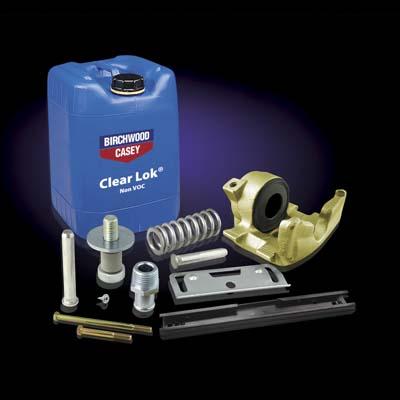
CLEARLOK Polyurethane Sealant from Birchwood Casey provides a clear, hard, high gloss protective finish over trivalent zinc chromate finishes without significant dimensional change. The CLEARLOK Polyurethane coating is designed to enhance the durability and sales appeal of the newer trivalent chromates used over zinc plated surfaces. Completely nonpolluting, CLEARLOK enhances the appearance and gloss of the final finish while improving corrosion and scratch resistance.
Easily applied using a dip tank process, the CLEARLOK water-based formula dries quickly and rapidly achieves full hardness and scuff resistance. Rated for corrosion resistance of 48 to 72 hours of neutral salt spray or several hundred hours of humidity exposure, the CLEARLOK Sealant is easy to use on any production scale plating line. Supplied as a concentrated liquid, the product is diluted with tap water to form a thin liquid of dipping viscosity. Easily implemented on most zinc plating lines, freshly chromated parts can be immersed immediately in the CLEARLOK solution following the last rinse.
Racked parts can be immersed, then warm-dried in a conventional drying station. Smaller, barrel-plated parts can be coated in a dip/spin cycle, in which they are unloaded into a spin-dry basket, then dipped in the CLEARLOK bath, and given a short heated spin to sling off excess liquid and dry the film onto the parts. The result is a clear, high gloss coating that dries to a hard, durable film with minimal 0.2 mil thickness. CLEARLOK Polyurethane is ideal for use on all types of zinc parts including hand tools, decorative or functional hardware, fasteners and automotive components.
Contact Details
Related Glossary Terms
- corrosion resistance
corrosion resistance
Ability of an alloy or material to withstand rust and corrosion. These are properties fostered by nickel and chromium in alloys such as stainless steel.
- hardness
hardness
Hardness is a measure of the resistance of a material to surface indentation or abrasion. There is no absolute scale for hardness. In order to express hardness quantitatively, each type of test has its own scale, which defines hardness. Indentation hardness obtained through static methods is measured by Brinell, Rockwell, Vickers and Knoop tests. Hardness without indentation is measured by a dynamic method, known as the Scleroscope test.
- tap
tap
Cylindrical tool that cuts internal threads and has flutes to remove chips and carry tapping fluid to the point of cut. Normally used on a drill press or tapping machine but also may be operated manually. See tapping.
